Aprilia RSV 1000 R, RSV 1000 R FACTORY Workshop Manual
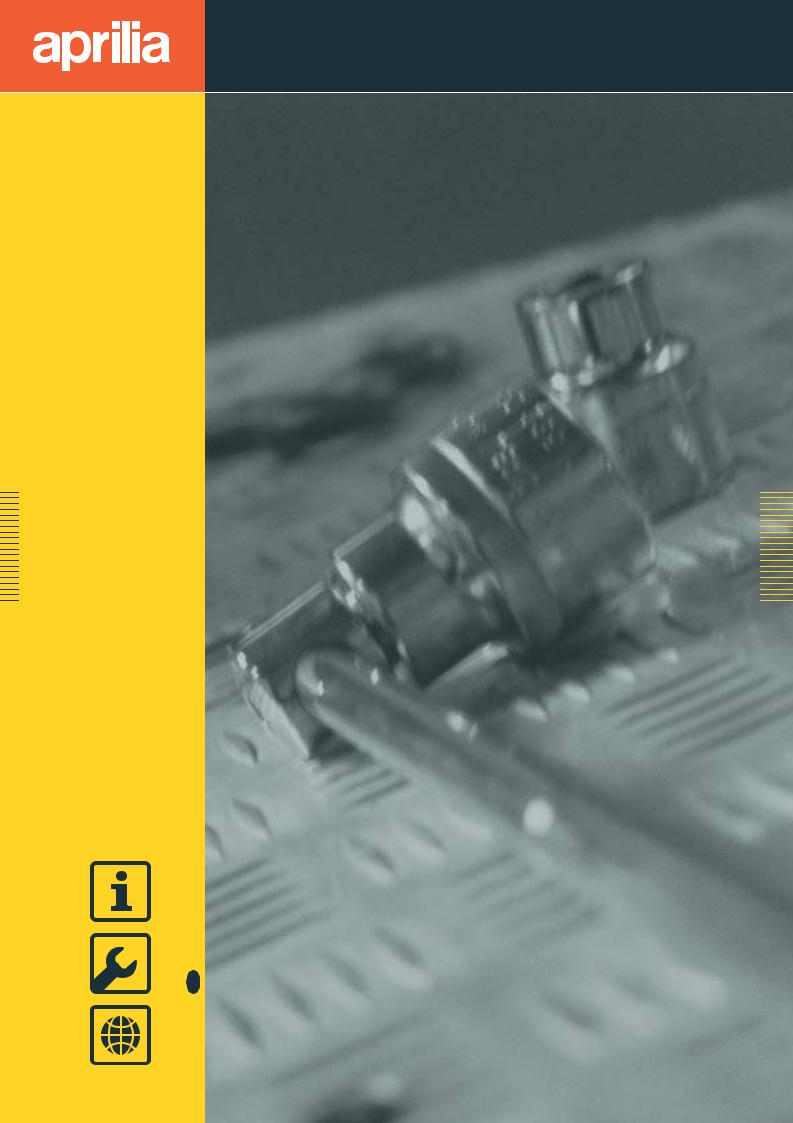
1137 3 RSV 1000 R - RSV 1000 R FACTORY
00/2003-10
<![if ! IE]><![endif]>www.serviceaprilia.com
workshopmanual
<![if ! IE]><![endif]>USA
<![endif]>8140742

INTRODUCTION
RSV 1000 R - RSV 1000 R FACTORY
INTRODUCTION |
0 |
0 - 1

INTRODUCTION |
|
|
|
|
RSV 1000 R - RSV 1000 R FACTORY |
|
SUMMARY |
|
0.1. |
INTRODUCTION ............................................................................................................................................. |
3 |
0.1.1. |
INTRODUCTION.................................................................................................................................... |
3 |
0.1.2. |
REFERENCE MANUALS....................................................................................................................... |
4 |
0.1.3. |
ABBREVIATIONS/SYMBOLS/CONVENTIONS..................................................................................... |
5 |
0 - 2

INTRODUCTION
RSV 1000 R - RSV 1000 R FACTORY
0.1.INTRODUCTION
0.1.1.INTRODUCTION
-This manual provides the information required for normal servicing.
-This publication is intended for use by Aprilia dealerships and their qualified mechanics; many concepts have been omitted inasmuch as their inclusion would be superfluous for such an audience. Since complete mechanical explanations have not been included in this manual, the reader must be familiar with basic notions of mechanics, as well as with basic repair procedures. Without such familiarity, repairs and checks could be ineffective and even hazardous. Since the repair and vehicle check instructions are not exhaustive, special care must be taken to prevent damage and injury. To ensure maximum customer satisfaction with the vehicle, Aprilia S.p.A. continuously improves its products and their documentation. The main technical modifications and changes in repair procedures are communicated to all Aprilia dealerships and agencies worldwide. Such modifications will be supplied in subsequent editions of the manual. In case of doubt regarding specific repairs or checks, contact the Aprilia SERVICE DEPARTMENT; we will be pleased to provide all necessary information and assistance as well as keeping you updated on changes and modifications to the vehicle.
Aprilia S.p.A. reserves the right to make changes to its products at any time, barring any such changes as may alter the essential features of a product as specified in the relevant manual.
All rights of storage using electronic means, reproduction and total or partial adaptation, whatever the means adopted, are reserved in all countries.
The mention of third parties’ products is only made for information purposes, and constitutes no engagement. Aprilia S.p.A. is not liable in any way for the performance or use of their products.
First edition: October 2003
Designed and printed by:
DECA srl
via Risorgimento, 23/1 - 48022 Lugo (RA) - Italy Tel. +39 - 0545 35235
Fax +39 - 0545 32844 E-mail: deca@decaweb.it www.decaweb.it
On behalf of:
Aprilia S.p.A.
Via G. Galilei, 1 – 30033 Noale (VE) – Italy Tel. +39 – (0)41 58 29 111
Fax +39 – (0)41 58 29 190 www.aprilia.com www.serviceaprilia.com
0 - 3
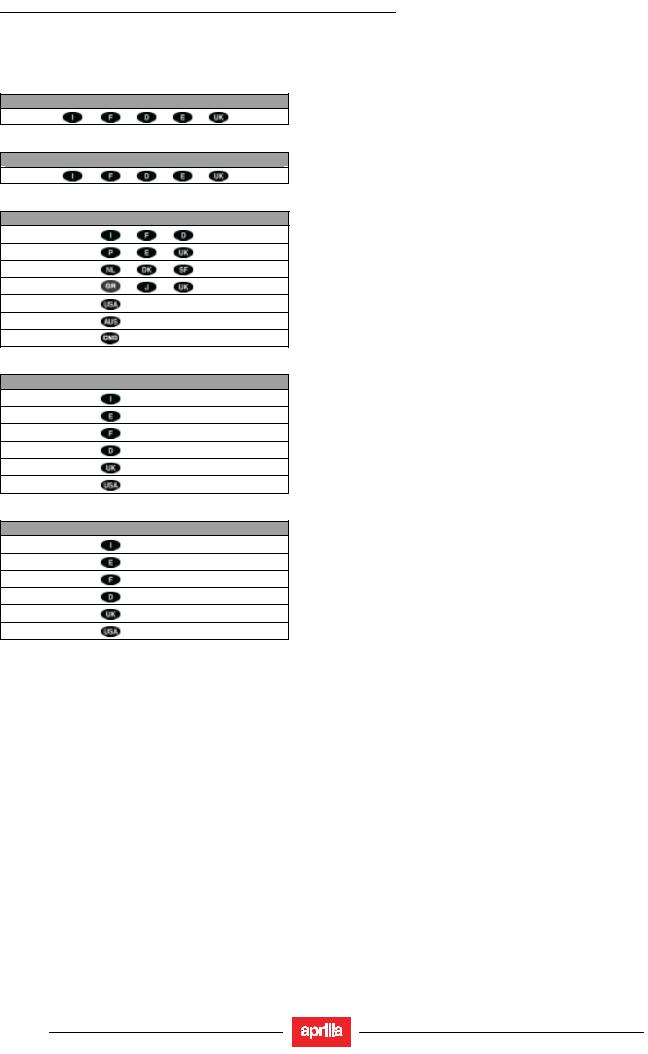
INTRODUCTION
RSV 1000 R - RSV 1000 R FACTORY
0.1.2.REFERENCE MANUALS
PARTS CATALOGUES
Aprilia part# (description)
3974
SPECIAL TOOLS CATALOGUES
Aprilia part# (description)
001A00
OWNER’S MANUALS
Aprilia part# (description)
8104334
8104691
8104692
8104693
8104704
8104694
8104695
CYCLE PARTS TECHNICAL MANUAL
Aprilia part# (description)
8140737
8140738
8140739
8140740
8140741
8140742
ENGINE TECHNICAL MANUAL
Aprilia part# (description)
8140743
8140744
8140745
8140746
8140747
8140748
0 - 4

INTRODUCTION
RSV 1000 R - RSV 1000 R FACTORY
0.1.3.ABBREVIATIONS/SYMBOLS/CONVENTIONS
#= number
<= less than
>= greater than
≤= less than or equal to
≥= more than or equal to
~= approximately
∞= infinity
°C |
= degrees Celsius (centigrade) |
°F |
= degrees Fahrenheit |
±= plus or minus
AC |
= alternating current |
A= Ampere
Ah |
=Ampere per hour |
API |
= American Petroleum Institute |
HV |
= high voltage |
AV/DC |
= Anti-Vibration Double Countershaft |
bar |
= pressure measurement (1 bar =100 kPa) |
DC. |
= Direct Current |
cc |
= cubic centimeters |
CO |
= carbon monoxide |
CPU |
= Central Processing Unit |
DIN |
= German industrial standards (Deutsche Industrie Norm) |
DOHC |
= Double Overhead Camshaft |
ECU |
= Electronic Control Unit |
rpm |
= revolutions per minute |
HC |
= unburnt hydrocarbons |
ISC |
= Idle Speed Control |
ISO |
= International Standardization Organization |
Kg |
= kilograms |
Kgm |
= kilogram meter (1 kgm =10 Nm) |
km |
= kilometers |
kph |
= kilometers per hour |
kΩ |
= kilo Ohm |
kPa |
= kiloPascal (1 kPa =0.01 bar) |
KS |
= clutch side (from the German "Kupplungseite") |
kW |
= kiloWatt |
l= liters
LAP |
= racetrack lap |
LED |
= Light Emitting Diode |
LEFT |
|
SIDE |
= left side |
m/s |
= meters per second |
max |
= maximum |
mbar |
= millibar (1 mbar =0.1 kPa) |
mi |
= miles |
MIN |
= minimum |
MPH |
= miles per hour |
MS |
= flywheel side (from the German "Magnetoseite") |
MΩ |
= megaOhm |
N.A. |
= Not Available |
N.O.M.M. |
= Motor Octane Number |
N.O.R.M. |
= Research Octane Number |
Nm |
= Newton meter (1 Nm =0.1 kgm) |
Ω= ohm
PICK-UP |
= pick-up |
BDC |
= Bottom Dead Center |
TDC |
= Top Dead Center |
PPC |
= Pneumatic Power Clutch |
0 - 5

INTRODUCTION |
|
|
||
RSV 1000 R - RSV 1000 R FACTORY |
||||
RIGHT |
|
|
||
|
|
|
||
|
|
|
||
SIDE |
= right side |
|||
SAE |
= Society of Automotive Engineers |
|||
TEST |
= diagnostic check |
|||
T.B.E.I. |
= crown-head Allen screw |
|||
T.C.E.I. |
= cheese-head Allen screw |
|||
T.E. |
= hexagonal head |
|||
TP |
= flat head screw |
|||
TSI |
= Twin Spark Ignition |
|||
UPSIDE- |
|
|
|
|
DOWN |
= inverted fork |
|||
V= Volt
W= Watt
Ø= Diameter
0 - 6

GENERAL INFORMATION
RSV 1000 R - RSV 1000 R FACTORY
GENERAL INFORMATION |
1 |
1 - 1

GENERAL INFORMATION |
|
|
|
|
RSV 1000 R - RSV 1000 R FACTORY |
|
SUMMARY |
|
1.1. |
STRUCTURE OF THE MANUAL..................................................................................................................... |
3 |
1.1.1. |
CONVENTIONS USED IN THE MANUAL ............................................................................................. |
3 |
1.1.2. |
SAFETY WARNINGS............................................................................................................................. |
4 |
1.2. |
GENERAL RULES........................................................................................................................................... |
5 |
1.2.1. |
BASIC SAFETY RULES......................................................................................................................... |
5 |
1.3. |
DANGEROUS ELEMENTS ............................................................................................................................. |
8 |
1.3.1. |
WARNINGS ........................................................................................................................................... |
8 |
1.4. |
RUNNING-IN ................................................................................................................................................. |
12 |
1.4.1. |
RUNNING-IN RECOMMENDATIONS.................................................................................................. |
12 |
1.5. |
VEHICLE IDENTIFICATION.......................................................................................................................... |
13 |
1.5.1. |
POSITION OF THE SERIAL NUMBERS ............................................................................................. |
13 |
1.6. |
POSITION OF THE WARNING ADHESIVE LABELS.................................................................................... |
15 |
1.6.1. |
POSITION OF THE WARNING ADHESIVE LABELS .......................................................................... |
15 |
1.6.2. |
CALIFORNIA EVAPORATIVE EMISSION SYSTEM .......................................................................... |
25 |
1 - 2
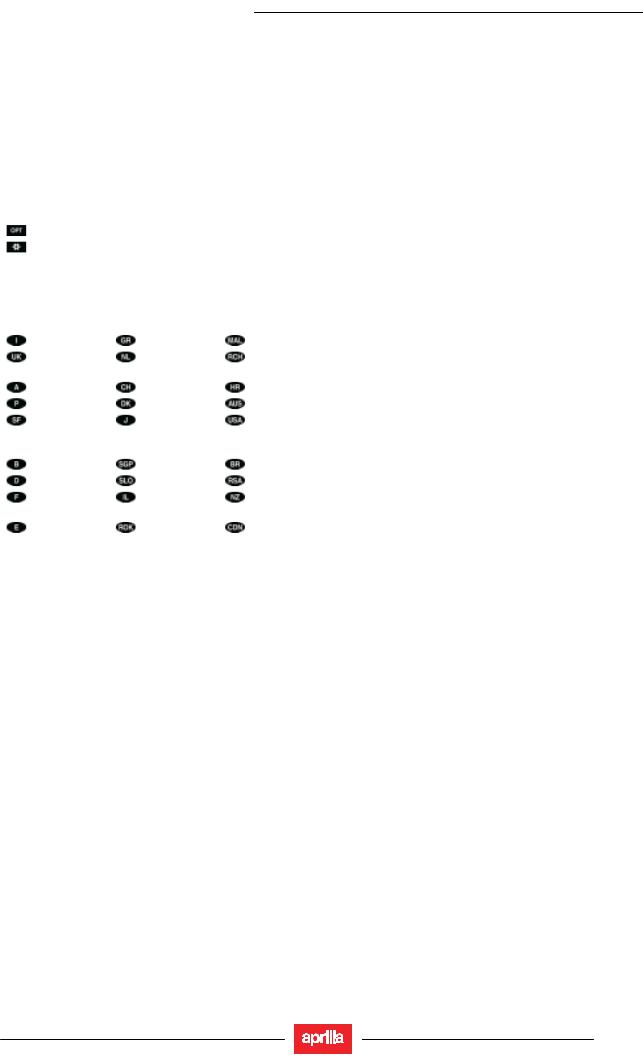
GENERAL INFORMATION
RSV 1000 R - RSV 1000 R FACTORY
1.1.STRUCTURE OF THE MANUAL
1.1.1.CONVENTIONS USED IN THE MANUAL
•This manual is divided in sections and subsections, each covering a set of the most significant components. Refer to the index of sections when consulting this manual.
•Unless otherwise expressly specified, assemblies are reassembled by reversing the dismantling procedure.
•The terms "right" and "left" are referred to the rider seated on the vehicle in the normal riding position.
•Motorcycle’s operation and basic maintenance are covered in the «OWNER'S MANUAL».
In this manual any variants are identified with these symbols:
optional catalytic version
-all versions
MP |
national certification |
|
|
SF |
European certification (EURO 1 limits) |
|
|
VERSION: |
|
|
|
|
Italy |
Greece |
Malaysia |
|
United |
Holland |
Chile |
|
Kingdom |
|
|
|
Austria |
Switzerland |
Croatia |
|
Portugal |
Denmark |
Australia |
|
Finland |
Japan |
United |
|
|
|
States of |
|
|
|
America |
|
Belgium |
Singapore |
Brazil |
|
Germany |
Slovenia |
South Africa |
|
France |
Israel |
New |
|
|
|
Zealand |
|
Spain |
South |
Canada |
|
|
Korea |
|
1 - 3

GENERAL INFORMATION
RSV 1000 R - RSV 1000 R FACTORY
1.1.2.SAFETY WARNINGS
The following precautionary warnings are used throughout this manual in order to convey the following messages:
Safety warning. This symbol appears, whether in the manual or on the vehicle itself, to indicate a personal injury hazard. Non-compliance with the indications given in the messages preceded by this symbol may result in very serious risks for your and other people's safety and for the vehicle!
WARNING
Indicates a potential hazard which may result in serious injury or even death.
CAUTION
Indicates a potential hazard which may result in minor personal injury or damage to the vehicle.
IMPORTANT: The word "IMPORTANT" in this manual precedes important information or instructions.
1 - 4
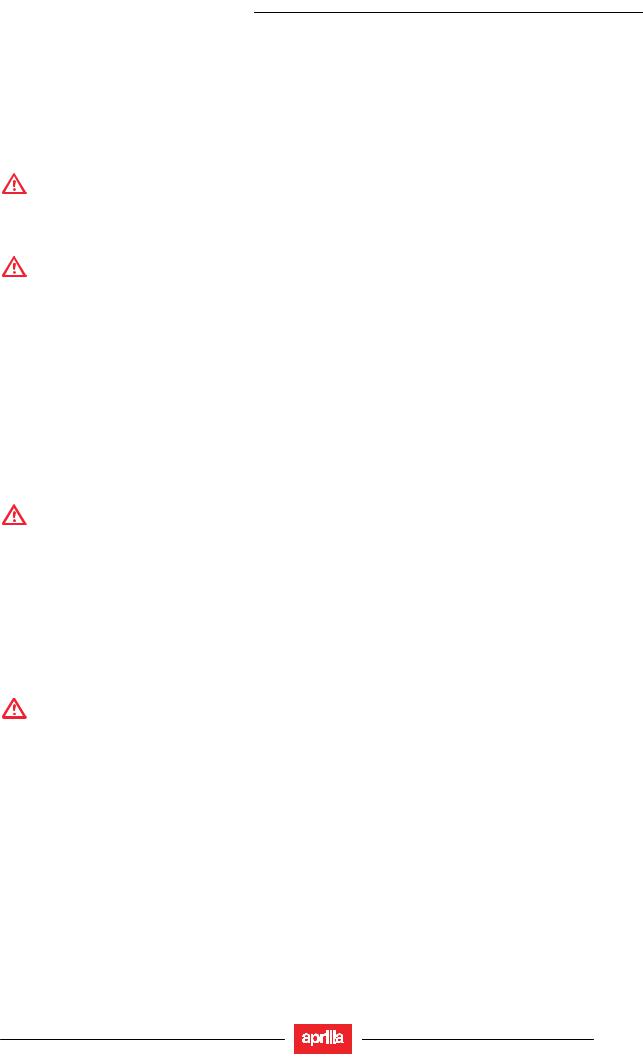
GENERAL INFORMATION
RSV 1000 R - RSV 1000 R FACTORY
1.2. GENERAL RULES
1.2.1.BASIC SAFETY RULES
CARBON MONOXIDE
Should it be necessary to perform some operations with the vehicle running, make sure to work outdoors or in a wellaerated room.
Avoid starting the engine in closed or badly ventilated rooms.
In case you are working indoors, use an exhaust gases’ scavenging system.
DANGER
Exhaust gases contain carbon monoxide, which is extremely toxic if inhaled and may cause loss of consciousness or even lead to death by asphyxia.
FUEL
DANGER
The fuel used to operate engines is highly flammable and becomes explosive under particular conditions. Refueling and engine service should take place in a well-ventilated area with the engine turned off. Do not smoke when refueling or in the proximity of sources of fuel vapors, avoid flames, sparks and any element that could ignite fuel or provoke explosions.
DO NOT DISPOSE OF FUEL IN THE ENVIRONMENT.
KEEP IT AWAY FROM CHILDREN.
HIGH-TEMPERATURE COMPONENTS
The engine and the exhaust system parts become hot and continue to be hot even for some time after the engine has been stopped.
Before handling these parts, wear insulating gloves or wait for the engine and the exhaust system to cool completely down.
USED GEARBOX AND FORK OILS
DANGER
In case any maintenance operation should be required, it is advisable to use latex gloves. Gear oil may cause serious damage to the skin if handled daily and for long periods. Wash your hands carefully after use.
Put it in a sealed container and take it to the filling station where you usually buy it or to an oil salvage center.
In case any maintenance operation should be required, it is advisable to use latex gloves.
DO NOT DISPOSE OF OIL IN THE ENVIRONMENT
KEEP IT AWAY FROM CHILDREN.
BRAKE FLUID
WARNING
When using the brake fluid, take care not to spill it on the plastic, rubber or painted parts, since it can damage them.
When carrying out the maintenance operations on the braking system, use a clean cloth to cover these parts.
Always wear safety goggles when working on the braking system. The brake fluid is highly irritant. Avoid contact with your eyes.
If the brake fluid gets in contact with the skin or the eyes, carefully wash the parts of your body that get in contact with the fluid and consult a doctor.
KEEP IT AWAY FROM CHILDREN.
1 - 5
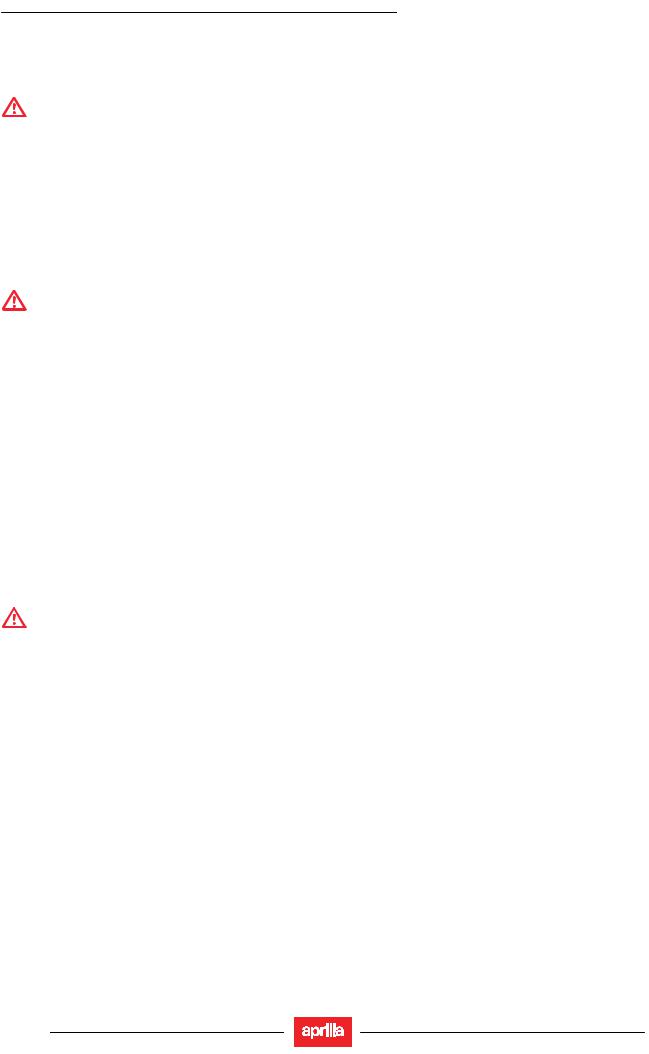
GENERAL INFORMATION
RSV 1000 R - RSV 1000 R FACTORY
COOLANT
The coolant is composed of ethylene glycol that, under certain conditions, can become inflammable and send forth invisible flames causing severe burns.
DANGER
Be careful not to spill the coolant on the red-hot parts of the engine and the exhaust system: it may catch fire and send forth invisible flames.
In case any maintenance operation should be required, it is advisable to use latex gloves.
Even if toxic, coolant has a sweet flavor. Never leave it inside open containers or within the reach of animals to prevent the risk of drinking.
KEEP IT AWAY FROM CHILDREN.
Do not remove the radiator plug when the engine is hot. The coolant is under pressure and could cause severe burns.
HYDROGEN GAS AND BATTERY ELECTROLYTE
DANGER
The battery electrolyte is a toxic, caustic substance containing sulphuric acid and thus able to cause severe burns in case of contact.
Always wear tight gloves and protective clothes when handling this fluid.
If the electrolyte gets in contact with the skin, carefully wash the parts of your body that get in contact with the fluid with abundant fresh water.
Always use a protection for your eyes since even a very small amount of the battery fluid can cause blindness. In the event of contact with your eyes, carefully wash them with water for fifteen minutes and then consult immediately an eye specialist.
Should you accidentally drink some fluid, drink abundant water or milk, then drink milk of magnesia or vegetable oil and consult a doctor immediately. The battery releases explosive gases. Keep flames, sparks, cigarettes and any other heat source away from it. Make sure the room is well aerated when servicing or recharging the battery.
KEEP IT AWAY FROM CHILDREN.
The battery fluid is corrosive.
Do not pour it on the plastic parts.
Make sure that the electrolyte acid is suitable for the type of battery used.
GENERAL PRECAUTIONS AND INFORMATION
Follow these instructions closely when repairing, disassembling or reassembling the motorcycle or its components.
DANGER
Using bare flames is strictly forbidden when working on the motorcycle. Before servicing or inspecting the motorcycle: stop the engine and remove the key from the ignition switch; allow for the engine and exhaust system to cool down; where possible, lift the motorcycle using adequate equipment placed on firm and level ground. Be careful of any parts of the engine or exhaust system which may still be hot to the touch to avoid scalds or burns.
Never put any mechanical parts or other vehicle components in your mouth when you have both hands busy. None of the motorcycle components is edible. Some components are harmful to the human body or toxic.
Unless expressly specified otherwise, motorcycle assemblies are refitted or re-assembled by reversing the removal or dismantling procedure. Where a procedure is cross-referred to relevant sections in the manual, proceed sensibly to prevent shifting any parts unless strictly necessary. Never attempt to polish matte-finished surfaces with lapping compounds.
Never use fuel instead of solvent to clean the motorcycle.
Do not clean any rubber or plastic parts or the seat with alcohol, gasoline or solvents. Clean with water and neutral detergent.
Always disconnect the battery negative (–) lead before soldering any electrical components.
When two or more persons service the same motorcycle together, special care must be taken to avoid personal injury.
BEFORE DISASSEMBLING ANY COMPONENTS
•Clean off all dirt, mud, and dust and clear any foreign objects from the vehicle before disassembling any components.
•Use the model-specific special tools where specified.
1 - 6
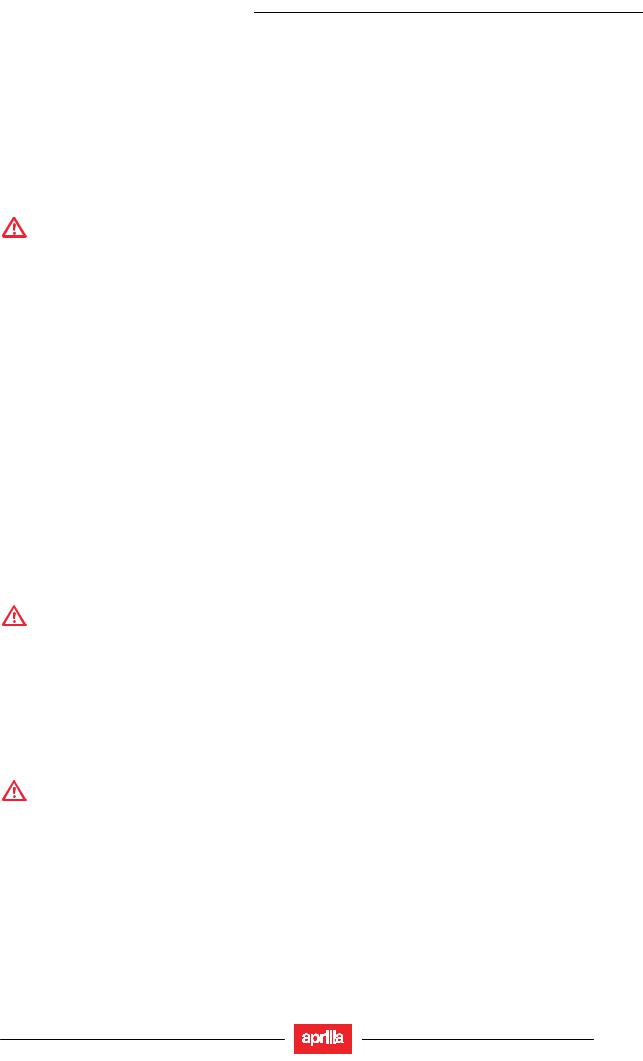
GENERAL INFORMATION
RSV 1000 R - RSV 1000 R FACTORY
DISASSEMBLING THE COMPONENTS
-Never use pliers or similar tools to loosen and/or tighten nuts and bolts. Always use a suitable wrench.
-Mark all connections (hoses, wiring, etc.) with their positions before disconnecting them. Identify each connection using a distinctive symbol or convention.
-Mark each part clearly to avoid confusion when refitting.
-Thoroughly clean and wash any components that you removed using a detergent with low flash point.
-Mated parts should always be refitted together. These parts will have seated themselves against one another in service as a result of normal wear and tear and should never be mixed up with other similar parts on refitting.
-Certain components are matched-pair parts and should always be replaced as a set.
-Keep the motorcycle and its components well away from heat sources.
REASSEMBLING THE COMPONENTS
DANGER
Never reuse a circlip or snap ring. These parts must always be replaced once they have been shifted. When fitting a new circlip or snap ring, take care to move the open ends apart just enough to allow fitting in the shaft.
Make a rule to check that a newly –fitted circlip or snap ring has located fully into its groove. Never clean a bearing with compressed air.
NOTE All bearings must rotate freely with no hardness or noise. Replace any bearings that do not meet these requirements.
-Use ORIGINAL Aprilia SPARE PARTS only.
-Use the specified lubricants and consumables.
-Where possible, lubricate a part before assembly.
-When tightening nuts and bolts, start with the largest or innermost nut/bolt and observe a cross pattern. Tighten e- venly in subsequent steps until achieving the specified torque.
-Replace any self-locking nuts, gaskets, seals, circlips or snap rings, O-rings, split pins, bolts and screws which have a damaged thread.
-Lubricate the bearings abundantly before assembly.
-Make a rule to check that all components you have fitted are correctly in place.
-After repairing the motorcycle and after each service inspection, perform the preliminary checks, and then drive the motorcycle in a private estate area or in a safe area away from traffic.
-Clean all joint surfaces, oil seal edges and gaskets before assembly. Apply a light coat of lithium grease along the edges of oil seals. Fit oil seals and bearings with the marking or serial number facing outwards (in view).
ELECTRICAL CONNECTORS
To disconnect the electrical connector, follow the procedures below. Failure to comply with these procedures may lead to irreparable damages to the connector and the wiring as well. If present, press the special safety hooks.
WARNING
Do not pull cables to disconnect the two connectors.
•Grasp the two connectors and disconnect them by pulling them in the two opposite directions.
•In case of dirt, rust, moisture, and so on, thoroughly clean the inside of the connectors with compressed air.
•Make sure that the cables are correctly fitted inside the connectors’ terminals.
NOTE The two connectors have just one correct positioning. Make sure to position them in the right direction.
Then fit the two connectors. Make sure they are correctly coupled (a click will be heard).
TIGHTENING TORQUE SETTINGS
DANGER
Always remember that the tightening torque settings of all wheel, brake, wheel shaft and other suspension parts play a fundamental role to ensure vehicle safety. Make sure that these values are always within the specified limits.
Check fastening parts tightening torque settings at regular intervals. Upon reassembly, always use a torque wrench.
Failure to comply with these recommendations could lead to the loosening and detachment of one of these parts with a consequent locking of the wheel or other serious troubles affecting the vehicle handling, and thus the risk of falls and serious injuries or death.
1 - 7
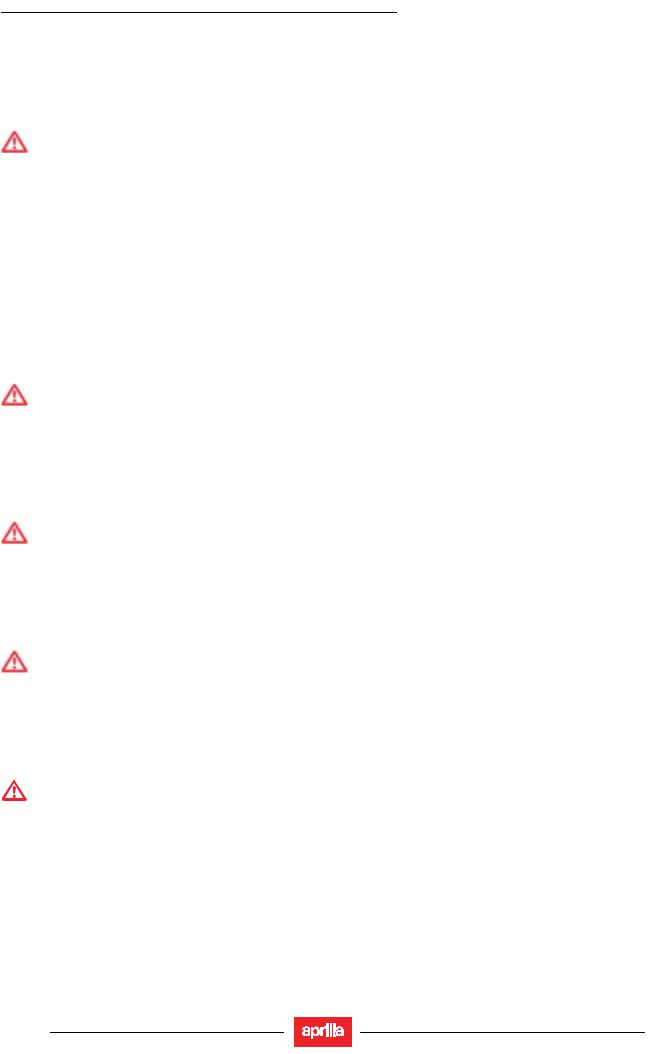
GENERAL INFORMATION
RSV 1000 R - RSV 1000 R FACTORY
1.3. DANGEROUS ELEMENTS
1.3.1.WARNINGS
FUEL
DANGER
The fuel used to operate engines is highly flammable and becomes explosive under particular conditions. Refueling and engine service should take place in a well-ventilated area with the engine turned off. Do not smoke when refueling or when near fuel vapors’ sources. Avoid contact with bare flames, sources of sparks or any other source which may ignite the fuel or lead to explosion.
Take care not to spill fuel out of the filler, or it may ignite when in contact with hot engine parts. In the event of accidental fuel spillage, make sure the affected area is fully dry before starting the engine. Fuel expands from heat and when left under direct sunlight.
Never fill the fuel tank up to the rim. Tighten the filler cap securely after each refueling.
Avoid contact with skin. Do not inhale vapors. Do not swallow fuel. Do not use a hose to transfer fuel between different containers.
DO NOT RELEASE FUEL INTO THE ENVIRONMENT. KEEP IT AWAY FROM CHILDREN.
Use only premium grade unleaded gas, min. O.N. 95 (N.O.R.M.) and 85 (N.O.M.M.).
LUBRICANTS
DANGER
A good lubrication ensures the vehicle’s safety.
Failure to keep the lubricants at the recommended level or the use of a non-suitable new and clean type of lubricant can lead to the engine’s or gearbox’s seizure, thus leading to serious accidents, personal injury or even death.
Gear oil may cause serious damage to the skin if handled daily and for long periods. Wash your hands carefully after use.
Do not dispose of oil into the environment.
Take it to the filling station where you usually buy it or to an oil salvage center.
WARNING
When filling the vehicle with this oil, take care not to spill it out since it could damage the vehicle paintwork.
In case of contact with oil, the tires’ surface will become very slippery, thus becoming a serious danger for your safety.
In case of leaks, do not use the vehicle. Check and trace the cause of leaks and proceed to repair.
ENGINE OIL
DANGER
Prolonged or repeated contact with engine oil may cause severe skin damage. Wash your hands thoroughly after handling engine oil.
Do not release it into the environment.
Dispose of engine oil through the nearest waste oil reclamation firm or through the supplier. Wear latex gloves during servicing.
FRONT FORK FLUID
DANGER
Front suspension response can be modified to a certain extent by changing the damping settings and/or selecting a particular grade of oil. Standard oil grade is SAE 20 W. Different oil grades can be selected to obtain a particular suspension response. (Choose SAE 5W for a softer suspension, 20W for a stiffer suspension).
The two grades can also be mixed in varying solutions to obtain the desired response.
1 - 8
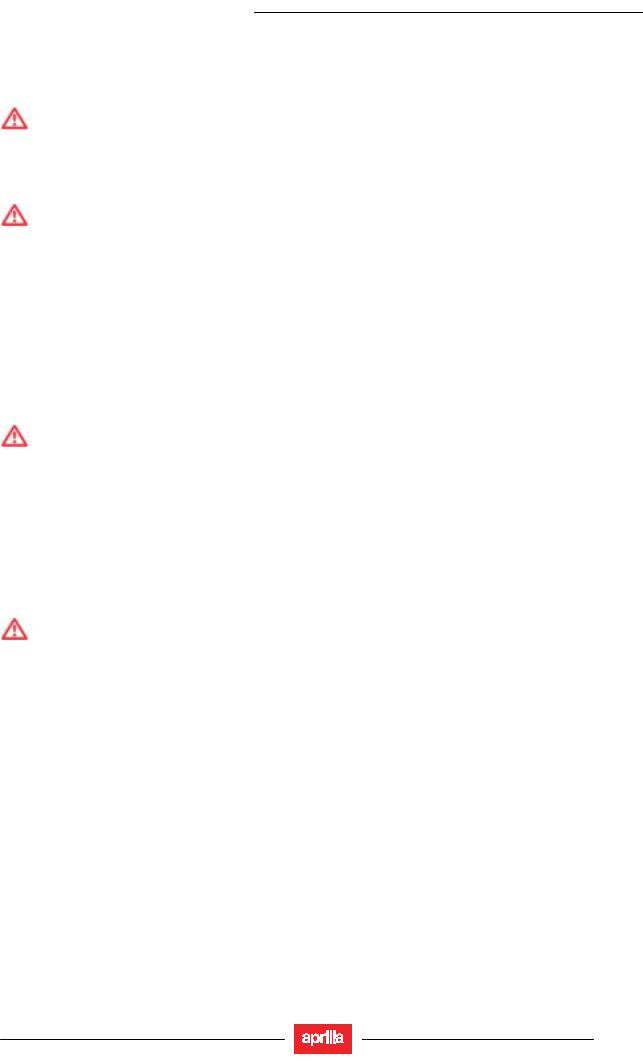
GENERAL INFORMATION
RSV 1000 R - RSV 1000 R FACTORY
BRAKE FLUID
NOTE This vehicle is fitted with front and rear disc brakes. Each braking system is operated by an independent hydraulic circuit. The information provided below applies to both braking systems.
DANGER
Do not use the vehicle in case brakes are worn out or do not work properly! The brakes are the parts that most ensure your safety and for this reason they must always be in perfectly working order. Failure to comply with these recommendations will probably lead to a crash or an accident, with a consequent risk of personal injury or death.
A wet surface reduces the brakes’ efficiency.
DANGER
In case of wet ground, double the braking distance since both brakes and tires drives on the road surface are extremely reduced by the water present on the road’s surface.
Any water on brakes, after washing the vehicle or driving on a wet road surface, crossing puddles or ditches can wet brakes so as to greatly reduce their efficiency.
Failure to comply with these recommendations may lead to serious accidents, with a consequent risk of severe personal injuries or death.
Brakes are critical safety components. Do not ride the vehicle in case brakes are not working at their best.
Check for the brakes’ proper working order before every trip. Brake fluid is an irritant. Avoid contact with eyes or skin.
In the event of accidental contact, wash the affected body parts thoroughly. In the event of accidental contact with eyes, contact an eye specialist or seek medical advice.
DO NOT RELEASE BRAKE FLUID INTO THE ENVIRONMENT. KEEP IT AWAY FROM CHILDREN.
When handling brake fluid, take care not to spill it onto plastic or paint-finished parts or they will damage.
DANGER
Do not use any brake fluids other than the specified type. Never mix different types of fluids to top up level, as this will damage the braking system.
Do not use brake fluid from containers that have been kept open or in storage for long periods.
Any sudden changes in play or hardness in the brake levers are warning signs of problems with the hydraulic circuits.
Ensure that the brake discs and brake linings have not become contaminated with oil or grease. This is particularly important after servicing or inspections.
Make sure the brake lines are not twisted or worn. Prevent accidental entry of water or dust into the circuit. Wear latex gloves when servicing the hydraulic circuit.
DISC BRAKES
DANGER
The brakes are the parts that most ensure your safety and for this reason they must always be in perfectly working condition; check them before every trip.
A dirty disc soils the pads.
Dirty pads must be replaced, while dirty discs must be cleaned with a high-quality degreaser. Perform the maintenance operations with half the indicated frequency if the vehicle is used in rainy or dusty areas, on uneven surfaces or on racetracks.
When the disc pads wear out, the level of the fluid decreases to automatically compensate for their wear. The front brake fluid reservoir is located on the right handlebar, near the front brake lever.
The rear brake fluid reservoir is located under the right fairing. Do not use the vehicle if the braking system is leaking fluid.
1 - 9
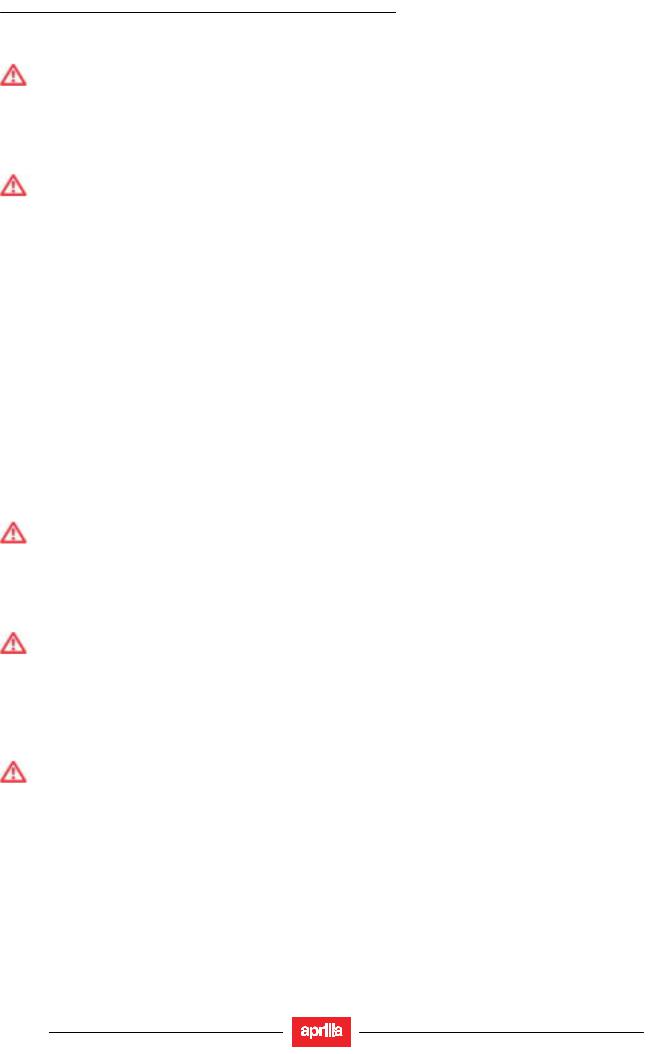
GENERAL INFORMATION
RSV 1000 R - RSV 1000 R FACTORY
COOLANT
DANGER
Coolant is toxic when ingested; it is an irritant, contact with eyes or skin may cause irritation.
In the event of contact with eyes, rinse repeatedly with abundant water and seek medical advice. In the event of ingestion, induce vomiting, rinse mouth and throat with abundant water and seek medical advice immediately.
DO NOT RELEASE INTO THE ENVIRONMENT. KEEP IT AWAY FROM CHILDREN.
DANGER
Take care not to spill coolant onto hot engine parts. It may ignite and produce invisible flames. Wear latex gloves when servicing.
Do not ride when coolant is below the minimum level.
Coolant mixture is a 50% solution of water and anti-freeze. This is the ideal solution for most operating temperatures and provides good corrosion protection.
This solution is also suited for the warm season, as it is less prone to evaporative loss and will reduce the need for topups.
In addition, less water evaporation means fewer minerals salts depositing in the radiator, which helps preserve the cooling system’s efficiency.
When temperature drops below zero degrees centigrade, check the cooling system frequently and add more anti-freeze (up to 60% maximum) to the solution.
Use distilled water in the coolant mixture. Tap water will damage the engine.
Refer to the chart given below and add water with the quantity of anti-freeze to obtain a solution with the desired freezing point:
Freezing point F°(C°) |
Coolant % of volume |
-4° (-20°) |
35 |
-22° (-30°) |
45 |
-40° (-40°) |
55 |
NOTE Coolants have different specifications. The protection degree is written on the label.
WARNING
Use nitrate-free coolant only, with a protection until at least -31°F (-35°C).
DRIVE CHAIN
Check the drive chain operation, slack and lubrication at regular intervals.
The vehicle is equipped with an endless chain with a joint link.
WARNING
If too slack, the chain can come off the front or rear sprockets thus leading to serious accidents and damage to the vehicle, with consequent serious personal injury or death.
Do not use the vehicle if the chain tension has not been correctly adjusted.
To check the chain, take it with your hand where it turns on the rear sprocket and pull it as to separate it from the crown itself.
If you can move the chain apart of the front sprocket for more than 0.125 in (3 mm), change chain, crown and pinion.
DANGER
If not properly maintained, the chain can undergo early wear out and lead to the damage of both crown and pinion.
Perform chain maintenance operations more frequently if the vehicle is used on rainy or dusty areas.
1 - 10

GENERAL INFORMATION
RSV 1000 R - RSV 1000 R FACTORY
TIRES
WARNING
If tires are excessively inflated, the vehicle will be hard and uneasy to ride, thus making you feel not at your ease.
In addition the roadworthiness, mainly on wet surfaces and during cornering, will be impaired. Flat tires (insufficient pressure) can slip on the rim and make you lose control of the vehicle. In this case too, both vehicle roadworthiness, handling and brake efficiency will be impaired.
Tires changing, repair, maintenance and balancing must be carried out by specialized technicians using suitable equipment.
When new, tires can have a thin slippery protective coating. Drive carefully for the first kilometers (miles). Never use rubber treating substances on tires.
In particular, avoid contact with fluid fuels, leading to a rapid wear. In case of contact with oil or fuel, do not clean but change tires.
DANGER
Some of the factory-assembled tires of this vehicle are provided with wear indicators. There are several kinds of wear indicators.
For more information on how to check the wear, contact your Dealer. Visually check if the tires are worn and in this case have them changed. If a tire deflates while driving, stop immediately.
Avoid hard brakings or moves and do not close throttles too abruptly.
Slowly close throttle grip, move to the edge of the road and use the engine brake to slow down until coming to a halt.
Failure to comply with these recommendations can lead to serious accidents and consequent personal injuries or death.
Do not install tires with air tube on rims for tubeless tires and vice versa.
1 - 11
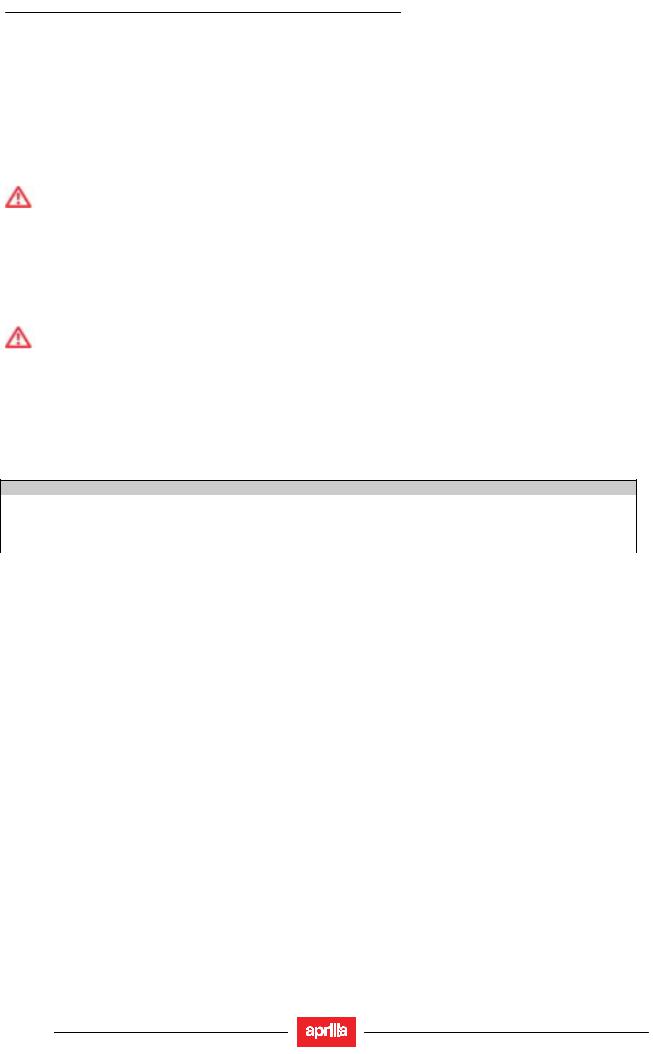
GENERAL INFORMATION
RSV 1000 R - RSV 1000 R FACTORY
1.4. RUNNING-IN
1.4.1.RUNNING-IN RECOMMENDATIONS
Running-in the engine is essential to ensure its duration and correct functioning.
If possible, drive on hilly roads and/or roads with many bends, so that the engine, the suspensions and the brakes undergo a more effective running-in.
During the running-in, change speed.
In this way the components are first "loaded" and then "relieved" and the engine’s parts can thus cool down. Even if it is important to stress the engine components during running-in, take care not to over do it.
WARNING
You can expect the best performance levels from the vehicle only after the first 932 mi (1500 km) of run- ning-in.
Keep to the following indications:
•Do not open the throttle completely if the speed is low, both during and after the running-in.
•During the first 62 mi (100 km) pull the brakes with caution, avoiding sharp and prolonged braking. This ensures a correct bedding-in of the pads on the brake disc.
•During the first 621 mi (1000 km) never exceed 6000 rpm (see table).
WARNING
After the first 621 mi (1000 km), Dealers carry out the checks indicated in the column "After runningin", see (REGULAR SERVICE INTERVALS CHART), in order to avoid hurting yourself or other people and/or damaging the vehicle.
•Between the first 621 mi (1000 km) and 932 mi (1500 km) drive more briskly, change speed and use the maximum acceleration only for a few seconds, in order to ensure better coupling of the components; never exceed 7500 rpm (see table).
•After the first 932 mi (1500 km) you can expect better performance from the engine, however, without exceeding the maximum allowed [11000 rpm].
Engine maximum rpm recommended
Mileage mi (Km) |
rpm |
0÷621 (1000 ) |
6000 |
621÷932 (1000÷1500 ) |
7500 |
Over 932 (1500) |
11000 |
1 - 12
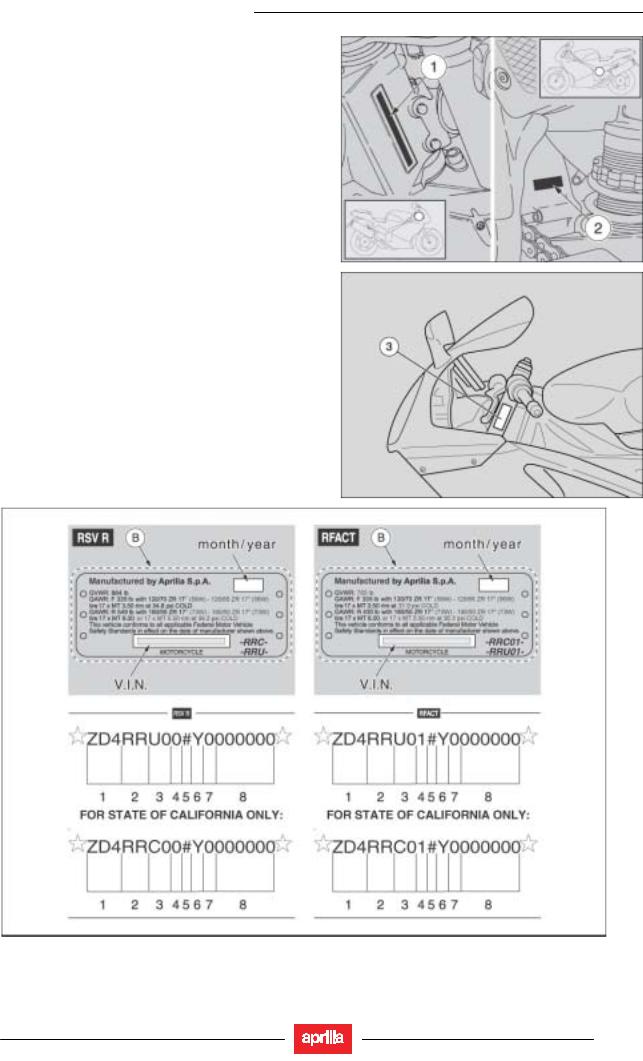
RSV 1000 R - RSV 1000 R FACTORY
1.5. VEHICLE IDENTIFICATION
1.5.1.POSITION OF THE SERIAL NUMBERS
These numbers are necessary for the vehicle’s registration.
IMPORTANT Do not alter the identification numbers if you do not want to incur severe penal and administrative sanctions; in particular, altering the frame number voids the warranty.
FRAME NUMBER
The frame number (1) is stamped on the right hand side of the headstock.
ENGINE NUMBER
The engine number (2) is stamped on the rear part of the engine, near the pinion.
INFORMATION CONTAINED IN THE VEHICLE IDENTIFICATION NUMBER
Description of the vehicle identification number (V.I.N.), stamped on the steering head of the frame (1) and on the identification plate (3)
GENERAL INFORMATION
1 - 13

GENERAL INFORMATION
RSV 1000 R - RSV 1000 R FACTORY
DIGIT MEANING
1.Manufacturer’s identification alphanumeric code.
2.Vehicle type.
3.Model.
4.Country for which the vehicle is intended.
5.#= Check digit number.
6.Model year.
7.Assembling factory designation (N = NOALE-VE- ,
S = SCORZÉ -VE- ,
0 = NOT SPECIFIED).
8.Sequential serial number.
1 - 14
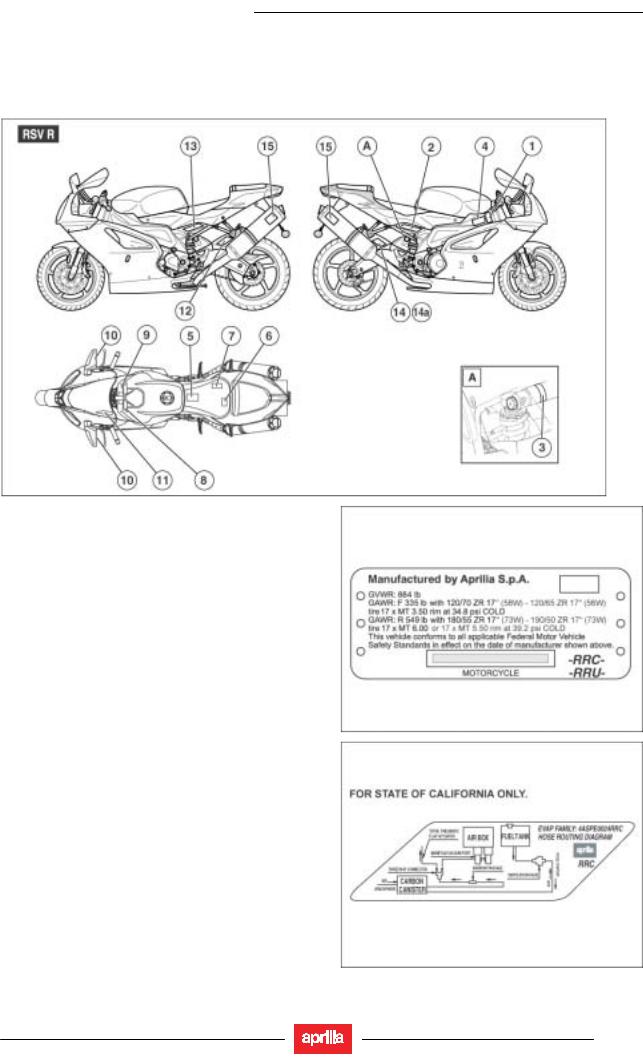
RSV 1000 R - RSV 1000 R FACTORY
1.6.POSITION OF THE WARNING ADHESIVE LABELS
1.6.1.POSITION OF THE WARNING ADHESIVE LABELS
1
2
GENERAL INFORMATION
1 - 15

GENERAL INFORMATION
RSV 1000 R - RSV 1000 R FACTORY
3
4
5
6
1 - 16
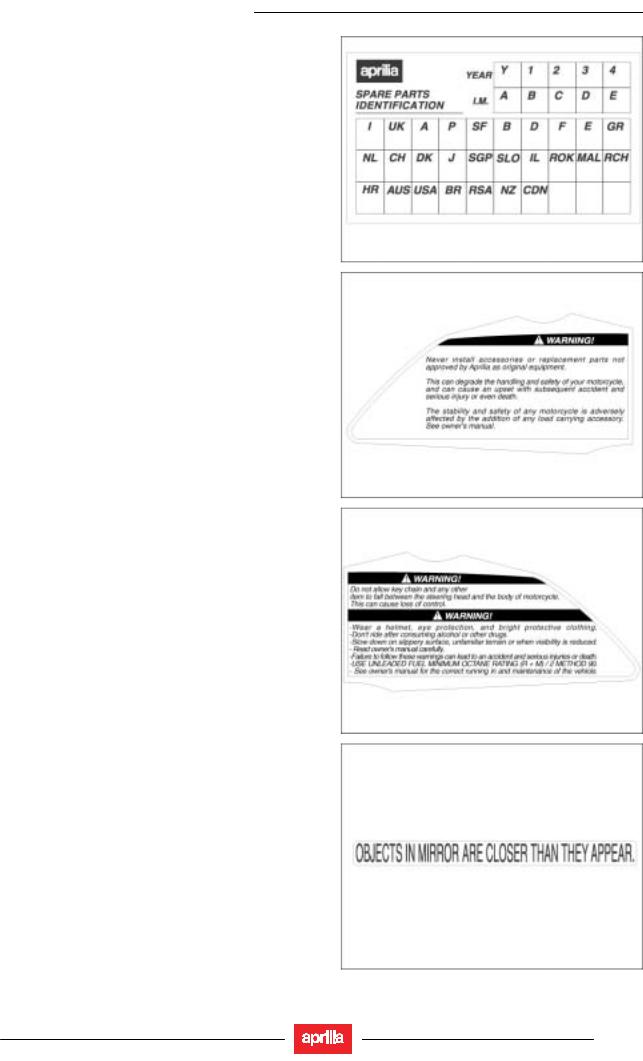
GENERAL INFORMATION
RSV 1000 R - RSV 1000 R FACTORY
7
8
9
10
1 - 17
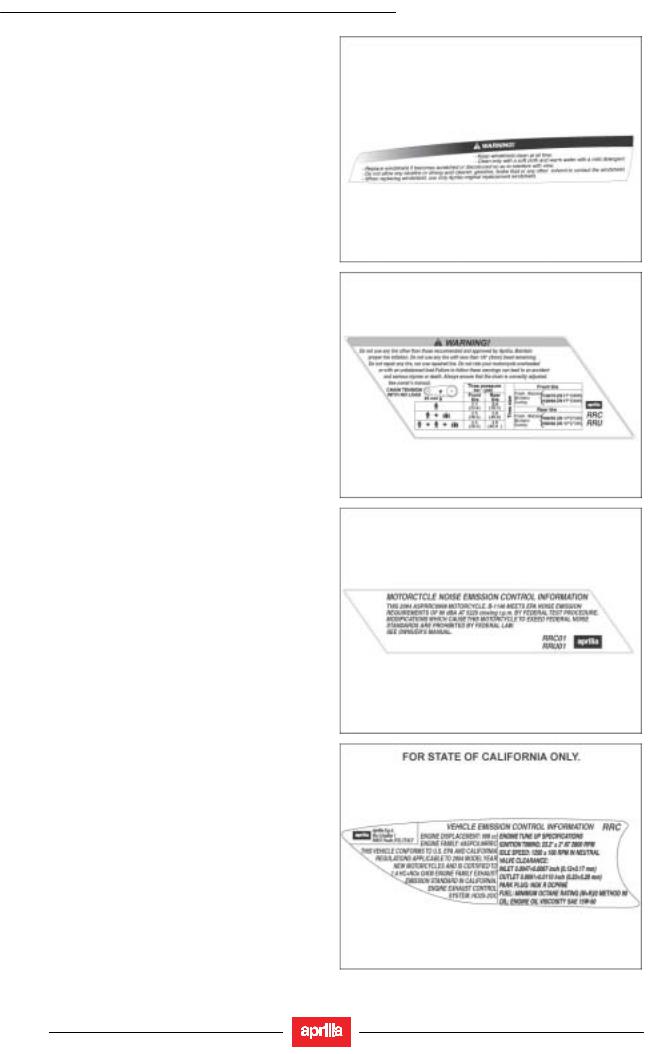
GENERAL INFORMATION
RSV 1000 R - RSV 1000 R FACTORY
11
12
13
14
1 - 18
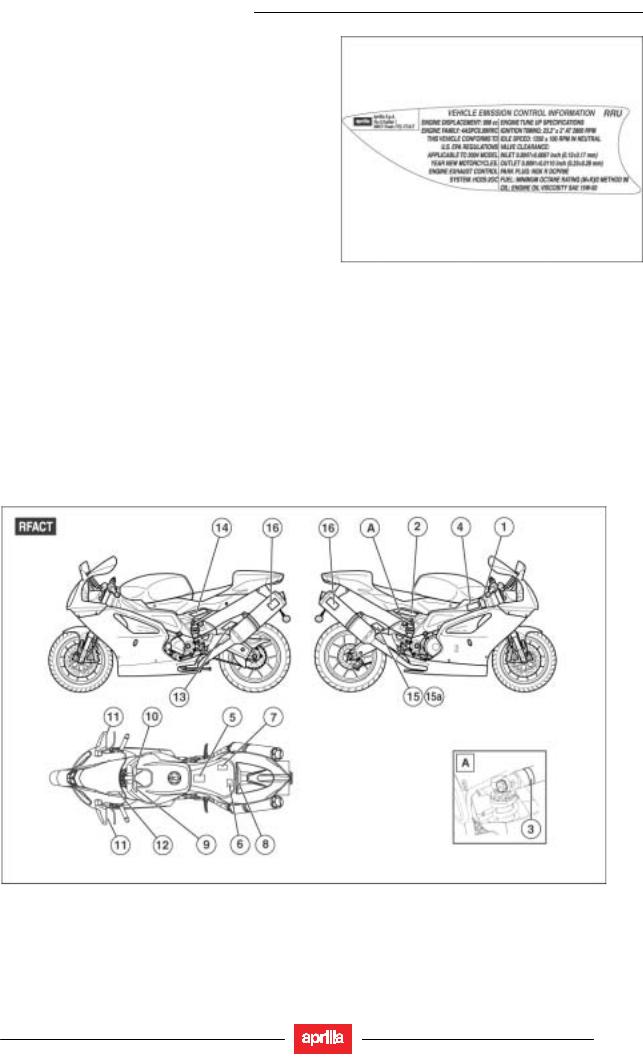
GENERAL INFORMATION
RSV 1000 R - RSV 1000 R FACTORY
14a
15 |
Muffler stamping |
1 - 19
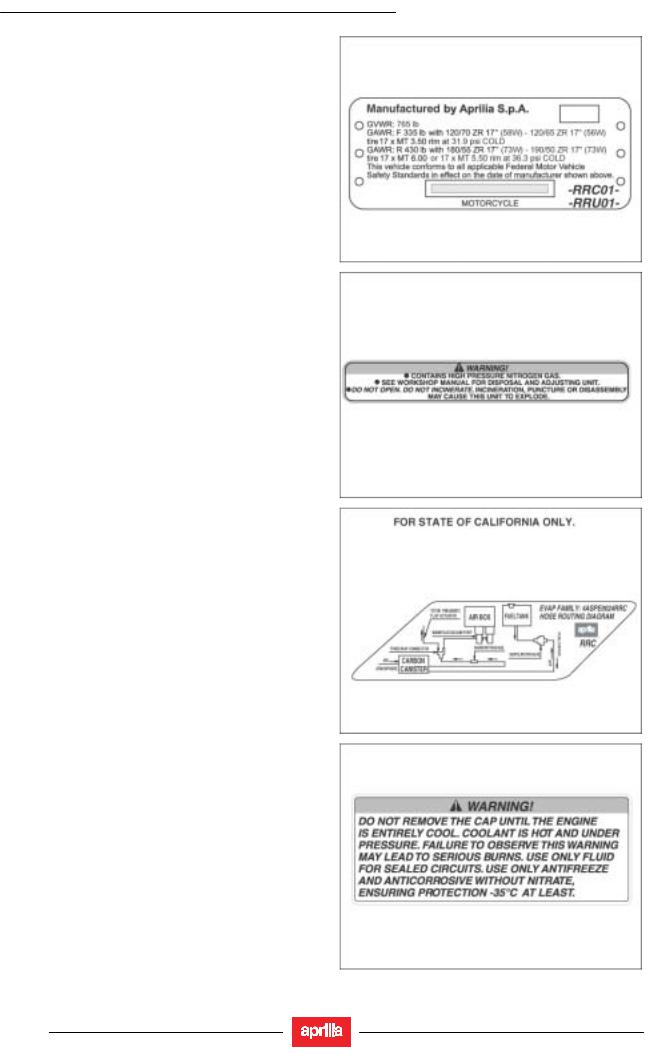
GENERAL INFORMATION
RSV 1000 R - RSV 1000 R FACTORY
1
2
3
4
1 - 20
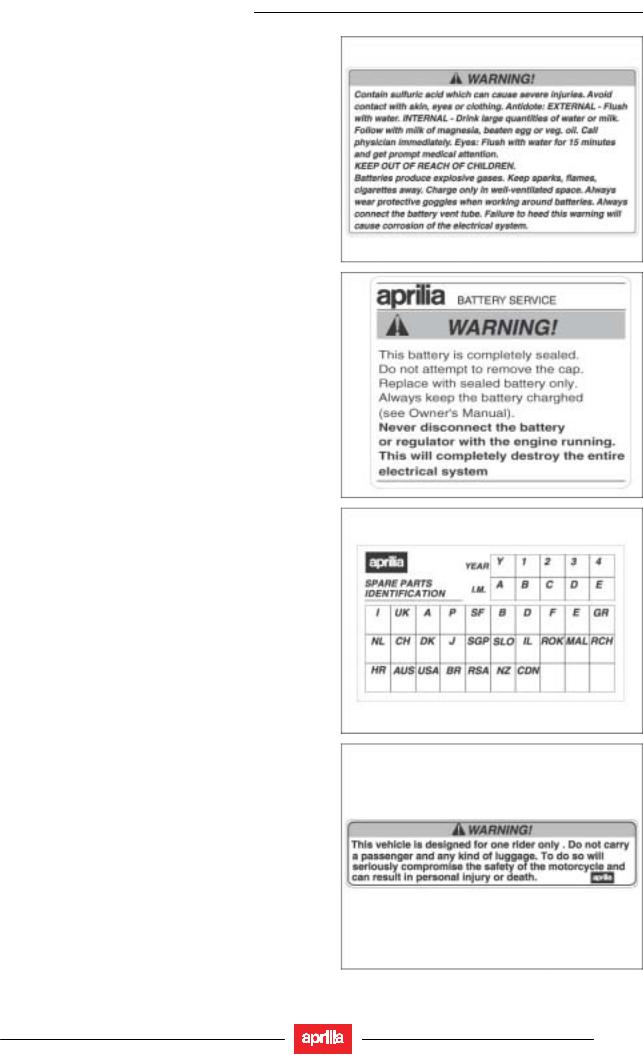
GENERAL INFORMATION
RSV 1000 R - RSV 1000 R FACTORY
5
6
7
8
1 - 21
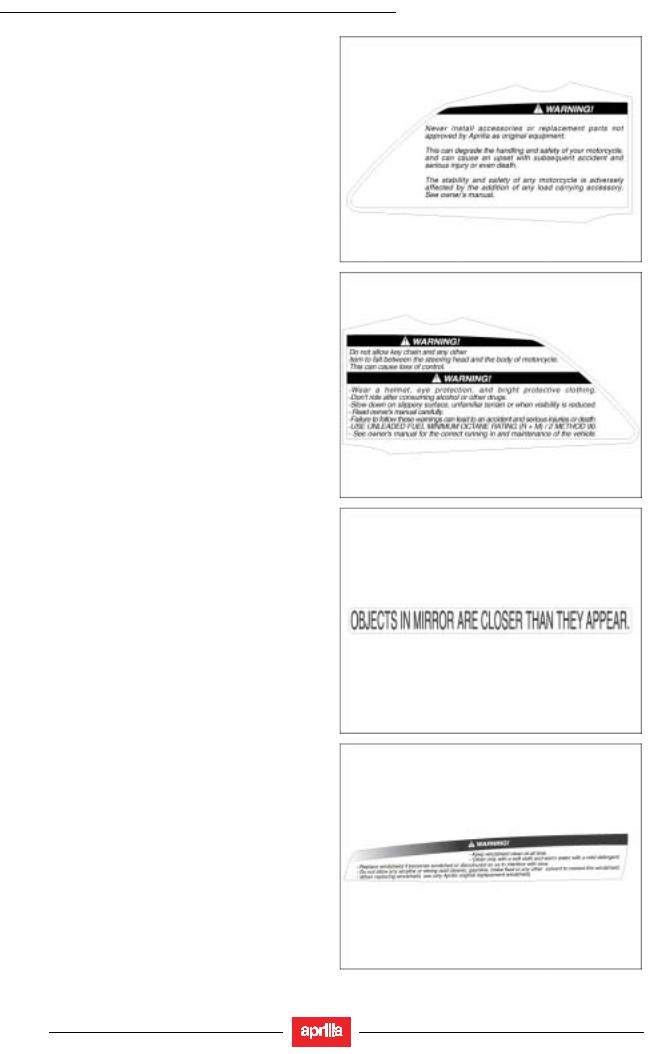
GENERAL INFORMATION
RSV 1000 R - RSV 1000 R FACTORY
9
10
11
12
1 - 22

GENERAL INFORMATION
RSV 1000 R - RSV 1000 R FACTORY
13
14
15
15a
1 - 23
